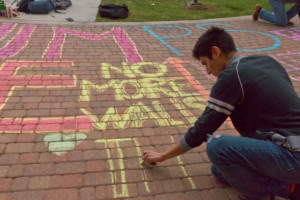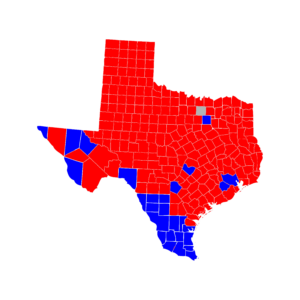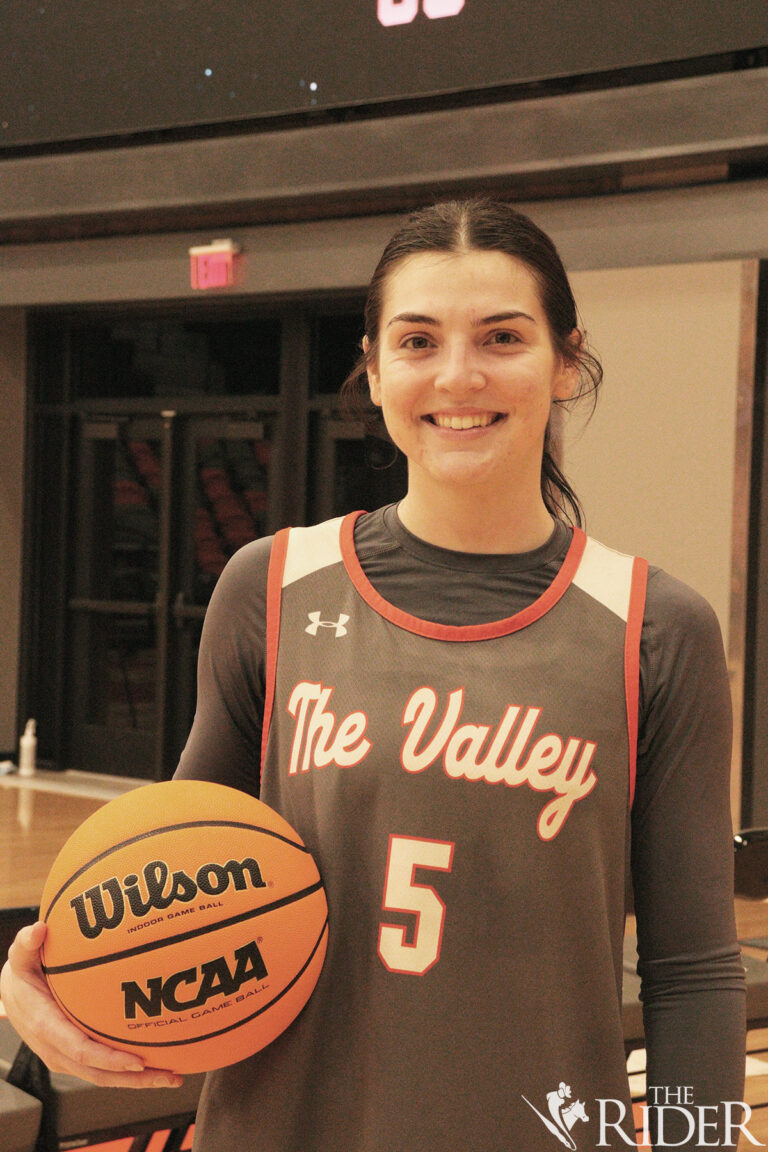
Jesus Zamora, a criminal justice freshman, writes messages against the border wall Wednesday in front of library on the Brownsville campus. Zamora was among a dozen students who wrote the messages in front of the main library on the Brownsville campus in reaction to the results of U.S. presiden al election. One student said they were not speaking against the U.S. presidential election on results, but rather the messages of hate and racism voiced by President-elect Donald Trump. MARIA RINCON/THE RIDER
Oscar Castillo | News Editor

Following one of the most unconventional presidential campaigns, which ended Tuesday with Republican Donald Trump defeating Democrat Hillary Clinton, the UTRGV campus community is reacting with uncertainty about the future.
About 13 students gathered last Wednesday night in front of the University Library on the Brownsville campus, not to protest the election results, but the president-elect’s “hate message.”
At the UT Austin campus, more than 250 students marched downtown in protest of Trump’s victory the day before.
“I don’t think that sort of general demonstrations against President Trump is really all that valuable, but I think that what people need to do is identify the issues that are important to them and organize with like-minded people and be active,” said UTRGV political science Professor Mark Kaswan.
Protests like UT Austin’s have taken place since Wednesday in most major U.S. cities, including New York, Boston, Chicago, Seattle and Washington, D.C., and at college campuses in California, Massachusetts, Michigan and Pennsylvania.
The anti-Trump protests across the nation chant the same message, “Not my president.”
Asked what Trump needed to do to unite the nation, Cameron County Republican Party Chair Morgan Graham said: “There are number of things that he has to do. But, there are number of things that we have to do. Over the course of his campaign, up to the primary, Donald Trump actually became far more palatable to a broader voter base. He actually became more moderate when it came to immigration. He met with the Latino groups to discuss the matter of the immigration policy toward the case of a more compassionate, conservative policy, which means that people who have been here and for most of their lives and contributing to the system will have the ability to continue to be here and contribute to the economy. So, what he needs to do is to continue along the line of what he has promised and to undo a lot of the damage that has been done by previous administrations from both parties.”
Cameron County Democratic Party Chair Amber Medina said she thinks it’s amazing the county voted in record numbers, and says she doesn’t know what Trump can do to unite the country since he created a lot of division during his campaign.
Hidalgo County Republican Party Chair Sergio Sanchez said Trump tapped into a deep-rooted desire to seek political change and he would need to address that in order to unite the country.
“There’s going to be many sit-downs before he takes office, many lunches and breakfasts with the different factions and political leaders up in D.C.,” Sanchez said. “There’s a few things he has to tackle, things that he promised. Things like addressing the broken immigration system in this country, and stopping illegal immigration and stop it as much as he can. The backlog against visas, people trying to get into the country legally and it’s not fair to them, but they have to wait so long and all that stuff. How to grow the economy again. He’s going to have to conduct a continuing series of sit-downs with the congressional leadership and the incoming congressional leadership in order to hit the ground running at the beginning of next year.”
Although Trump did win the Electoral College, 279 to 228 as of press time Thursday, Clinton won the popular vote by more than 200,000 votes.
“The reality is, Clinton won the popular vote. Clinton won the popular vote by over 200,000 votes, according to the latest count, which means that Trump only won because of the Electoral College,” Kaswan said. “So, it’s a unique feature to the American political system. No other political system in the world has anything like the Electoral College. … It’s this very strange thing. It has now produced what we would call a corrupted result, for the second time in less than 20 years.”

In the 2000 election, Democratic candidate Al Gore lost to Republican George W. Bush in the Electoral College, 271 to 266, despite garnering 500,000 more votes than Bush.
“When the dust settles, more Americans would have voted for her than voted for him,” said Jerry Polinard, a UTRGV political science professor. “But because of the peculiar structure of the Electoral College, the way that works, he would win the college. That would be the fifth time this happened in our history.”
The U.S. elects a president on a state-by-state basis. Candidates either win or lose each individual state based on the plurality of the votes, not the majority. Once a winner is selected in a state, the state’s electoral votes, which are determined by the number of seats in Congress plus two for the number of members in the senate, are tallied up with all 50 states.
Texas’ 38 electoral votes went to Trump during election night after he received 800,000 more votes than Clinton.
“Politics in Texas becomes very, very different if people in the Rio Grande Valley start to vote on a regular basis and vote in significant numbers,” Kaswan said. “If we start to vote at the same level as the rest of the states, so above the statewide average, things will start to change. … If we start to get turnouts in the 60, 70, 80 percent range, we become the tail that wags the Texas dog.”
Of Hidalgo County’s 338,990 registered voters, 175,995 voted, a 51.92 percent turnout.
“It broke the record,” said Hilda Salinas, Hidalgo County election analyst. “
With about 197,700 registered voters in Cameron County, 134,229 voted, a 47 percent turnout. This is a 5 percent increase from the 2012 election, which was the highest turnout in the county, said Remi Garza, Cameron County elections administrator.
The polling site at UTRGV’s Edinburg campus had 5,834 ballots cast; the Brownsville campus had 1,008; and Texas Southmost College’s campus, 1,022.






